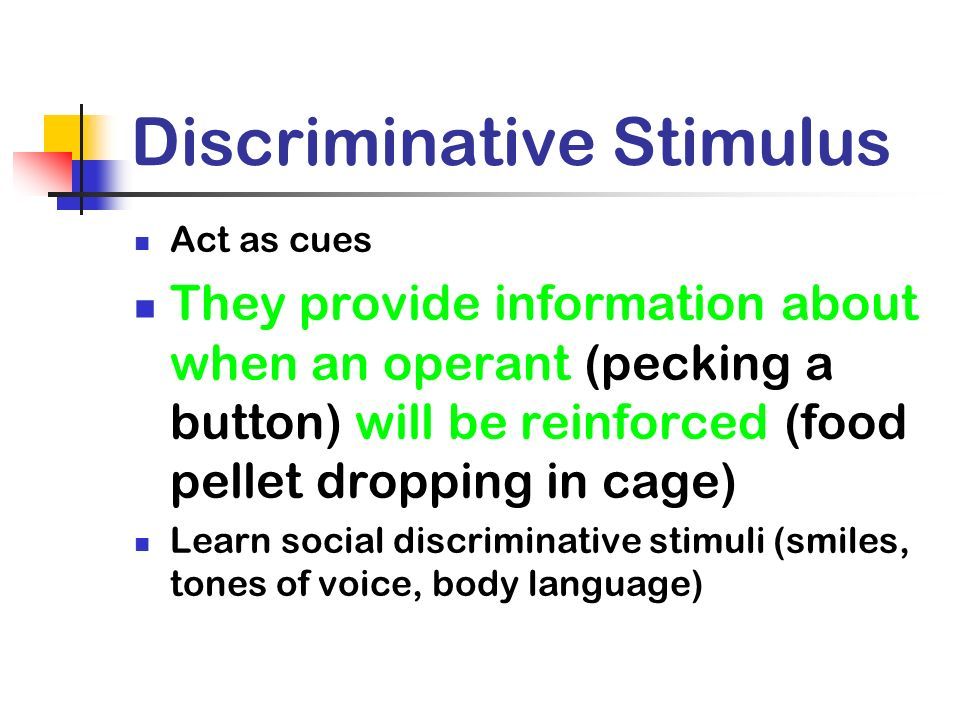Discriminative stimuli (Sd) are an essential concept in the field of behavior analysis. They are the stimuli in the environment that signal the availability or non-availability of reinforcement for a particular behavior. In other words, they tell us what behavior is going to get reinforced or punished. In this blog post, we will explore some examples of Sd in different contexts.
In the context of social skills, an Sd can be a social cue or signal that tells us what behavior is expected. For example, a classmate waving at us is an Sd that signals us to wave back or say hello. Similarly, a teacher calling our name is an Sd that signals us to pay attention and respond to their question or instruction. Failure to respond appropriately to these Sd can result in social awkwardness or even social exclusion.
In the context of animal training, an Sd can be a visual or auditory cue that signals the animal to perform a particular behavior. For example, a whistle blown by the trainer can be an Sd that signals the dog to come to them or perform a specific trick. Similarly, a light turned on in a pigeon’s cage can be an Sd that signals the pigeon to peck a particular key to receive a food reward.
In the context of education, an Sd can be a prompt or cue that signals the student to perform a particular behavior. For example, a teacher pointing to a picture in a book can be an Sd that signals the student to name the object in the picture. Similarly, a math problem written on the board can be an Sd that signals the student to solve the problem and receive a grade or reward.
In the context of everyday life, an Sd can be any stimulus that signals us to perform a particular behavior. For example, a red traffic light is an Sd that signals us to stop our vehicle. Similarly, a ringing phone is an Sd that signals us to answer the call or check the caller ID.
Sd is a crucial concept in behavior analysis that helps us understand how stimuli in the environment influence our behavior. Whether we are interacting socially, training animals, or learning in school, Sd plays a significant role in shaping our behavior. By identifying and responding appropriately to Sd, we can improve our social skills, academic performance, and overll quality of life.
Examples of SDs in ABA
In Applied Behavior Analysis (ABA), an SD or discriminative stimulus refers to a specific cue or signal that indicates to an individual that a particular behavior is more likely to result in reinforcement or consequences. An example of an SD in ABA is a teacher saying, “Please take out your math book and complete the first thre problems.” In this case, the teacher’s instruction is the discriminative stimulus that signals to the student that they should take out their math book and complete the first three problems. If the student follows the instruction, they are more likely to receive positive reinforcement, such as praise or a good grade. In other words, the SD is a signal or cue that sets the occasion for a particular behavior to occur and is a fundamental concept in ABA interventions.

The Meaning of SD in Behavior
An SD, or discriminative stimulus, is a signal or cue that indicates the availability of a specific consequence, such as a reward or punishment, for a particular behavior. In other words, an SD tells the person what behavior is likely to be reinforced or punished in a given situation. For example, a green traffic light is an SD for the behavior of driving through an intersection, as it signals that it is safe to do so. Similarly, a teacher’s verbal cue of “raise your hand” can serve as an SD for the behavior of raising one’s hand to ask a question in class. The use of SDs is an important part of behavior shaping and reinforcement, as they help individuals learn whch behaviors are appropriate and effective in different contexts.
Example of a Discriminative Stimulus
A discriminative stimulus is a cue in the environment that signals the availability of reinforcement for a particular behavior. An exmple of a discriminative stimulus could be a traffic light where the green light serves as an SD for drivers to go, while the red light serves as an SD for drivers to stop. Another example could be a classroom environment where the teacher’s voice serves as an SD for students to pay attention, while the noise from outside serves as an S-delta, signaling that paying attention is not necessary. an SD is any cue that signals the availability of reinforcement for a specific behavior.
Examples of S Delta
Sure, I’d be happy to provide a detailed answer to your question. An S Delta is a term used in behavior analysis to refer to a stimulus in the environment that signals the non-availability of reinforcement. In simpler terms, it is a signal that tells an individual that a particular behavior will not be rewarded or reinforced.
For example, let’s say that a child is used to receiving candy as a reward for completing their homework. However, one day the parent puts an “Out of Candy” sign on the candy jar. This sign serves as an S Delta, signaling to the child that candy is no longer availabe as a reward. As a result, the child may be less motivated to complete their homework since they know that they will not receive the usual reinforcement.
Another example of an S Delta could be a “Do Not Enter” sign on a door. This signal serves as an S Delta, telling individuals that they will not receive reinforcement by entering that door.
An S Delta is an environmental signal that communicates the non-availability of reinforcement for a particular behavior.
Examples of Discriminative Stimulus and S Delta
A discriminative stimulus (SD) is a stimulus in the environment that signals the availability of a particular consequence following a behavior. In other words, it is a cue or a signal that indicates when a certain behavior is likely to be reinforced or punished. For example, a red traffic light is a discriminative stimulus for stopping at an intersection.
Here are some more examples of SDs:
– A teacher’s instruction to raise your hand bfore speaking in class (SD for reinforcement of appropriate behavior)
– A dog’s owner reaching for the leash (SD for going on a walk)
– The sound of a phone ringing (SD for answering the phone)
On the other hand, an S Delta (Δ) is a stimulus in the environment that signals the absence of a particular consequence following a behavior. In other words, it is a cue or a signal that indicates when a certain behavior is unlikely to be reinforced or punished. For example, a green traffic light is an S Delta for stopping at an intersection.
Here are some more examples of S Deltas:
– A teacher’s instruction to not interrupt when another student is speaking (S Delta for reinforcement of inappropriate behavior)
– The absence of a dog’s owner reaching for the leash (S Delta for not going on a walk)
– The sound of a phone not ringing (S Delta for not answering the phone)
I hope this helps to clarify the difference between discriminative stimuli and S Deltas and provides some useful examples. Let me know if you have any further questions!

Example of Secondary Reinforcement
Sure, I’d be happy to provide a detailed answer to your question. Secondary reinforcement is a type of reinforcement that gains its reinforcing power through its association with primary reinforcement. In other words, a secondary reinforcer is something that has no inherent value on its own but becomes valuable because of its association with a primary reinforcer.
One common exaple of secondary reinforcement is money. Money has no inherent value, but we value it because we know we can use it to acquire things that do have value, such as food, clothing, and shelter. Money is therefore a secondary reinforcer because its reinforcing power comes from its association with primary reinforcers.
Another example of secondary reinforcement is praise. Praise has no inherent value, but we value it because we know it can lead to feelings of happiness and self-worth, which are primary reinforcers. When someone praises us for a job well done, we feel good about ourselves and are more likely to repeat that behavior in the future.
Secondary reinforcement is a type of reinforcement that gains its reinforcing power through its association with primary reinforcement. Money and praise are both examples of secondary reinforcement because they have no inherent value but become valuable because of their association with primary reinforcers.
The Meaning of SD as a Punishment
An SD for punishment, as defined by Cooper, Heron and Heward, is a stimulus that has been consistently present when a partcular behavior was punished. As a result, the presence of this stimulus signals to the individual that the behavior may result in punishment, and therefore the behavior occurs less frequently in its presence. It is important to note that an SD for punishment can be specific to each individual and their unique learning history, as what has been punished for one person may not have been punished for another. Additionally, it is essential to ensure that the use of punishment is ethical and effective, as it can have negative side effects and may not always result in long-term behavior change.
The Meaning of SD in Reinforcement
In the context of reinforcement, SD stands for “S-delta”, which refers to a specific type of stimulus that is associated with non-reinforcement. During discrimination training, animals are taught to respond in the presence of certain stimuli (called “S-deltas”) but to withhold their response when presented with the SD. The SD is essentially a signal to the animal that a certain behavior will not be reinforced, and therefore the animal learns to avoid that behavior in the presence of the SD. The process of discriminating between different stimuli and learning to respond appropriately to each one is an important part of reinforcement training, and the SD plays a crucial role in this process. Ultimately, the goal of discrimination training is to help animals learn to behave in a way that maximizes their chances of receiving reinforcement, while avoiding behaviors that are unliely to be rewarded.
The Impact of SD on Behavior
An SD has a profound effect on behavior as it acts as a signal that predicts the availability of reinforcement. When an organism encounters an SD, it learns that a paticular response will result in reinforcement. Consequently, the behavior of the organism is more likely to occur in the presence of the SD. This phenomenon is known as discrimination, and it refers to the ability of an organism to differentiate between an SD and other stimuli that do not predict reinforcement (SΔ). The behavior of the organism is under the control of the SD, and it is likely to occur only in the presence of the SD. Therefore, the presence of an SD can increase the probability of a particular behavior occurring, while the absence of the SD can decrease the likelihood of that behavior.
Understanding the Meaning of SD in Autism
In the context of autism, SD stands for “Discriminative Stimulus” and refers to a specific cue or signal that a person with autism may use to understand what is expected of them in a given situation. For example, an SD may be a visual cue, such as a picture or symbol, that signals to the person with autism that it is time to perform a crtain task or behavior.
The use of SDs is a common strategy in applied behavior analysis (ABA) therapy for individuals with autism, as it helps to establish clear expectations and promote more consistent responses to specific situations. By using consistent and clear SDs, individuals with autism may also be better able to generalize skills across different settings and situations, improving their overall independence and functioning.
The Impact of Red Light as a Discriminative Stimulus
A red light is a discriminative stimulus. A discriminative stimulus is any stimulus that signals the likelihood of a particular response being reinforced or punished. In the case of a red traffic light, it is a signal for drivers to stop their vehicles. It is associated with the punishment of receiving a traffic ticket or causing an accident if ignored. Hence, the red light discriminates the appropriate response of stopping, and this association is learned through experience and reinforced by the consequences of follwing or not following the signal. Therefore, a red light is a discriminative stimulus that signals the appropriate response of stopping.
The Impact of Green Lights as Discriminative Stimuli
A green light is a discriminative stimulus. In behavior analysis, a discriminative stimulus is a signal that indicates to an organism that a particular behavior is likely to result in a certain consequence or outcome. In the case of a traffic light, a green light serves as a discriminative stimulus for the behavior of applying pressure to the gas pedal. This means that when a driver sees a green light, they are more likely to press down on the gas pedal in order to move throgh the intersection. This behavior is reinforced by the consequence of reaching their destination more quickly. Therefore, a green light serves as a discriminative stimulus for the behavior of accelerating through an intersection.
Are SD and S Delta Similar?
SD (discriminative stimulus) and S-Delta are not the same. An SD is a stimulus that signals the availability of reinforcement for a particular response, meaning that the behavior is more likely to occur in the presence of the SD. On the other hand, an S-Delta is a stimulus that signals the absence of reinforcement for a particular response, meaning that the behavior is less likely to occur in the presence of the S-Delta. In other words, the presence of an SD increases the likelihood of a behavior being reinforced, wile the presence of an S-Delta decreases the likelihood of a behavior being reinforced. Therefore, the two stimuli have opposite effects on behavior and serve different functions in operant conditioning.
Examples of Discrimination Training
Discrimination training is a technique used in applied behavior analysis to teach individuals to differentiate between different stimuli and respond appropriately. An example of discrimination training would be teaching a child to identify and select a shoe from a group of items that includes a spoon and a toy. Initially, the child is presented with the shoe and taught to select it when directed to touch the shoe. Once the child is successful in identifying and selecting the shoe in isolation, the training progresses to presenting the shoe alongsde other items, such as a spoon and a toy, and asking the child to select the shoe. Through repetition and reinforcement, the child learns to discriminate between the shoe and other items and respond appropriately, ultimately acquiring the necessary skills to generalize this discrimination to other relevant situations.

Conclusion
Discriminative stimuli, or SDs, play a critical role in shaping behavior and learning. They signal the availability of reinforcement for a specific behavior, indicating to the individual what behavior will be rewarded. Examples of SDs can be found in a wide variety of contexts, from animal training to social interactions. For instance, in the case of social skills, a classmate waving to a student can serve as an SD, signaling the appropriate response. Conversely, stimuli that signal the non-availability of reinforcement, known as S-deltas, can also play a role in shaping behavior. By understanding the role that SDs play in behavior, individuals can better understand how to modify and shape thir own behavior or the behavior of others.
